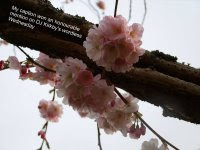 This place is absolutely beautiful (If you live here and have not been - go!!). I didn't know anything about the museum and had assumed, since there is a huge three headed elephant on top of the building, that it was dedicated to elephants and their history......in typical Thai style.....I was completely wrong!!
This place is absolutely beautiful (If you live here and have not been - go!!). I didn't know anything about the museum and had assumed, since there is a huge three headed elephant on top of the building, that it was dedicated to elephants and their history......in typical Thai style.....I was completely wrong!!The legend of Erawan is as follows:
Erawan is also known as Airavata, the king-god of elephants, who is ridden by the God Indra. The legend goes that Brahma held
 two halves of an eggshell in his hands over which he read seven sacred hymns - from the right half of the egg eight elephants emerged and from the left eight cow-elephants. The eight guardian deities who preside over the eight points of the compass were given an elephant each (If you are interested the deities are: East - Indra, South East – Agni, South – Yama, South West – Surya, West – Varuna, North West – Vayu, North – Kubera and North East – Soma) so that they could use them for the defence and protection of their allotted quarter of the world. Airavata, the king-god of elephants, is also known as Ardh-Matanga which means elephant of the clouds.
two halves of an eggshell in his hands over which he read seven sacred hymns - from the right half of the egg eight elephants emerged and from the left eight cow-elephants. The eight guardian deities who preside over the eight points of the compass were given an elephant each (If you are interested the deities are: East - Indra, South East – Agni, South – Yama, South West – Surya, West – Varuna, North West – Vayu, North – Kubera and North East – Soma) so that they could use them for the defence and protection of their allotted quarter of the world. Airavata, the king-god of elephants, is also known as Ardh-Matanga which means elephant of the clouds.  So when we got there I discovered that the museum was built as a home for a collection of priceless antiques that were believed to bring blessings and prosperity to Thailand and it's people. The owner wanted to build something that would keep the artefacts safe, would adhere to Eastern traditions and that was symbolic of the cosmography of the East. He decided to use the heavenly elephant Airavata (Erawan) as it's main symbol (Huge elephant which is sometimes depicted with thirty-three heads and sometimes with three) and designed the rest of the building around the Thai belief in three worlds.
So when we got there I discovered that the museum was built as a home for a collection of priceless antiques that were believed to bring blessings and prosperity to Thailand and it's people. The owner wanted to build something that would keep the artefacts safe, would adhere to Eastern traditions and that was symbolic of the cosmography of the East. He decided to use the heavenly elephant Airavata (Erawan) as it's main symbol (Huge elephant which is sometimes depicted with thirty-three heads and sometimes with three) and designed the rest of the building around the Thai belief in three worlds.
The ground floor represents the Underworld - This is where the Naga, said to be the guardian's of treasure, live. The Naga are a race of supernatural beings usually depicted with both snake and human attributes (You can't take photographs in this section so this is a picture of the Naga King and his wife and servant that I found). This section of the museum represents the Naga King's (Nagaradja) Palace and explains the idea behind the museum and has beautiful examples of Chinese porcelain, Vietnamese pottery, antique furniture, antique tea sets and it has a huge statue of the Nagaradja in the middle of the room (Obviously he's keeping an eye on all the artefacts!!)



 The elephants stomach represents Tavatimsa Heaven - According to Buddhism there are twenty realms of happy existence and the third one is known as Tavatisma Heaven. The term 'tavatimsa' means thirty-three and this heaven is named after thirty-three men who collectively dedicated their whole lives to the happiness and well-being of other
The elephants stomach represents Tavatimsa Heaven - According to Buddhism there are twenty realms of happy existence and the third one is known as Tavatisma Heaven. The term 'tavatimsa' means thirty-three and this heaven is named after thirty-three men who collectively dedicated their whole lives to the happiness and well-being of other people - When they died the leader of the group became ruler of this heaven, acquired the name Indra (I guess this is why Erawan sometimes has thirty-three heads!!) and pledged to protect the earth. I could have just sat in this section of the museum for hours - it was absolutely beautiful. The whole room was painted blue, the ceiling was decorated with a painting of the solar system and there were some stunning Buddah carvings.
people - When they died the leader of the group became ruler of this heaven, acquired the name Indra (I guess this is why Erawan sometimes has thirty-three heads!!) and pledged to protect the earth. I could have just sat in this section of the museum for hours - it was absolutely beautiful. The whole room was painted blue, the ceiling was decorated with a painting of the solar system and there were some stunning Buddah carvings.So......not a lot to do with the history of elephants but a really beautiful place to visit!!































































